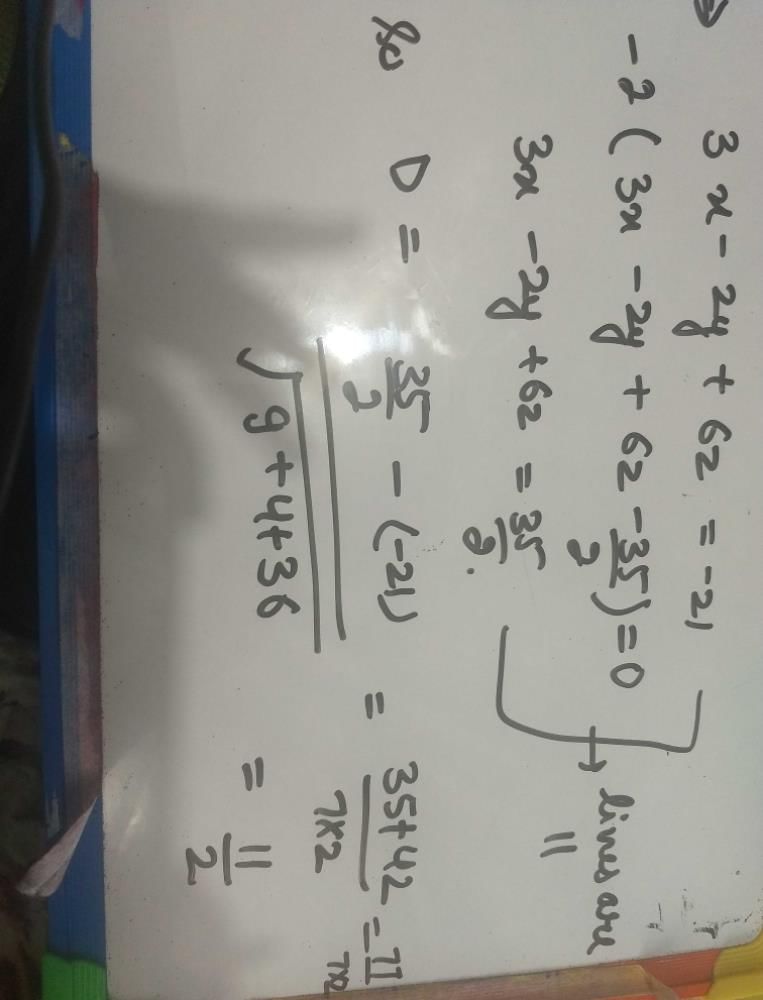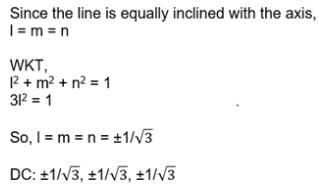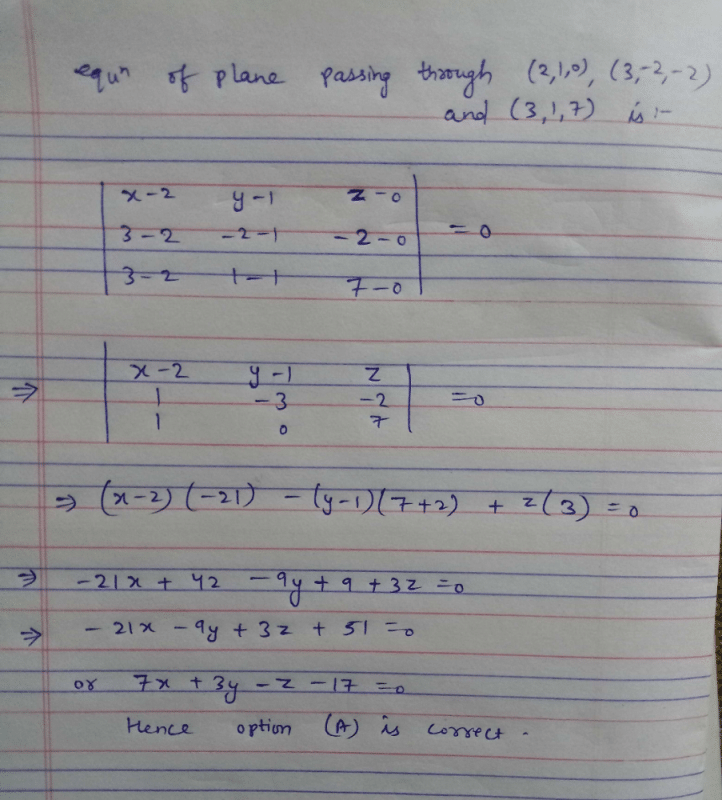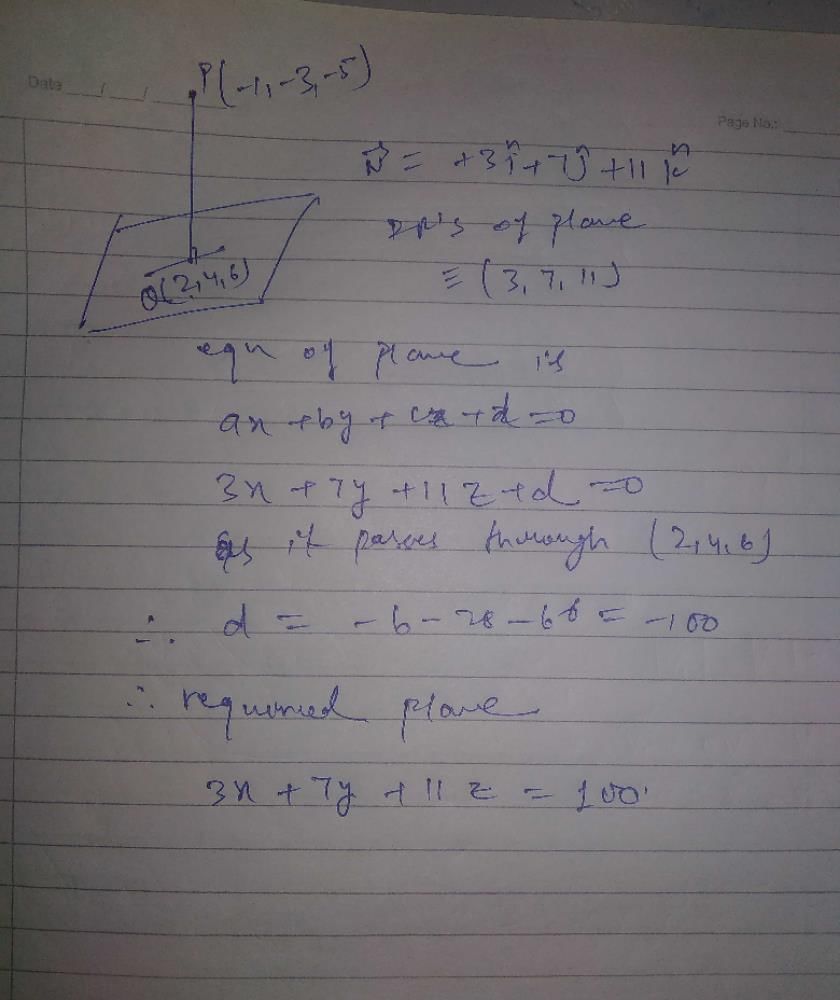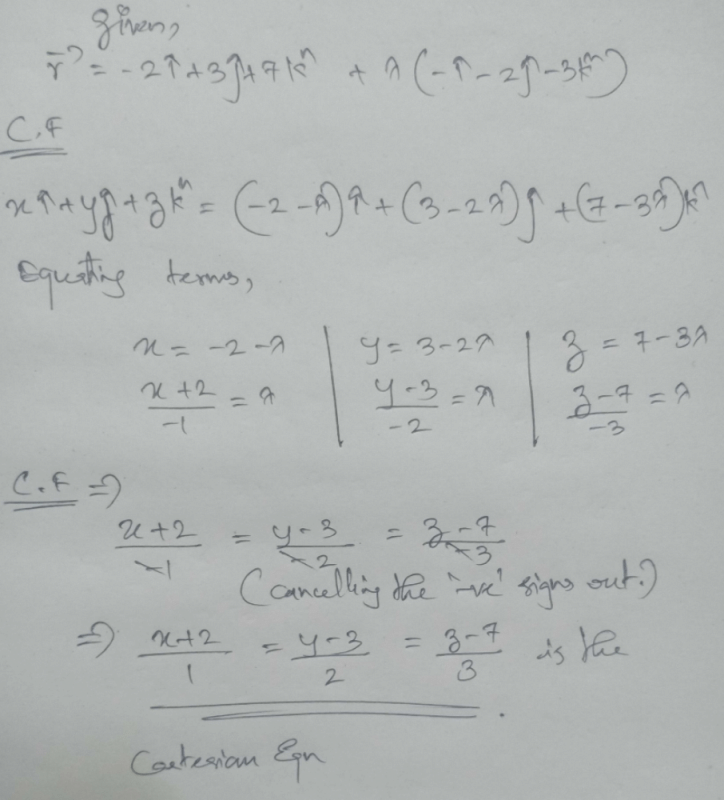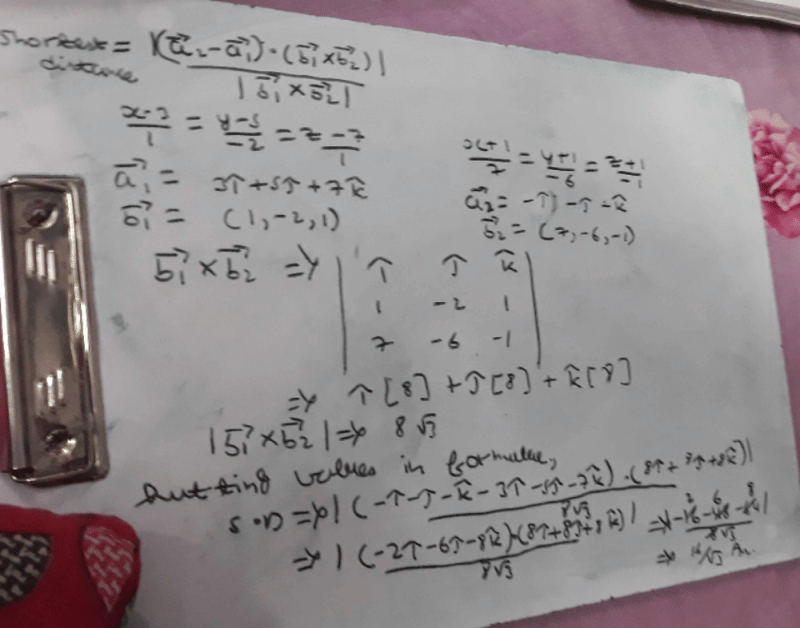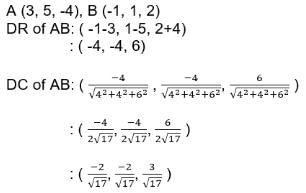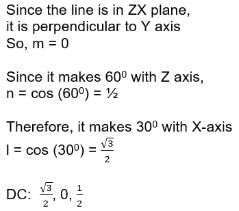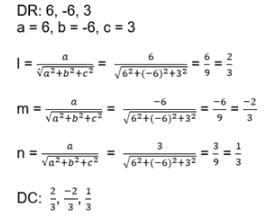All Exams >
JEE >
Mathematics CUET UG Mock Test Series 2026 >
All Questions
All questions of Chapter 11 - Three Dimensional Geometry for JEE Exam
Find the equation of the set of points which are equidistant from the points (1, 2 , 3) and (3, 2, -1)
a) x + 2z = 0
b) y + 2z = 0
c) x – 2z = 0
d) x – 2y = 0
Correct answer is option 'C'. Can you explain this answer?
|
|
Aryan Khanna answered |
Pt. A(1, 2 , 3)
Pt. B(3, 2, -1)
Let P(x,y,z)
So, AP = BP
((x-1)2 + (y-2)2 + (z-3)2)1/2 = ((x-3)2 + (y-2)2 + (z+1)2)1/2
(x-1)2 + (y-2)2 + (z-3)2) = (x-3)2 + (y-2)2 + (z+1)2
x2 +1 -2x + y2 + 4 - 4y + z2 + 9 – 6z = x2 +9 -6x + y2 + 4 - 4y + z2 + 1 + 2z
4x – 8z = 0
x – 2z = 0
Pt. B(3, 2, -1)
Let P(x,y,z)
So, AP = BP
((x-1)2 + (y-2)2 + (z-3)2)1/2 = ((x-3)2 + (y-2)2 + (z+1)2)1/2
(x-1)2 + (y-2)2 + (z-3)2) = (x-3)2 + (y-2)2 + (z+1)2
x2 +1 -2x + y2 + 4 - 4y + z2 + 9 – 6z = x2 +9 -6x + y2 + 4 - 4y + z2 + 1 + 2z
4x – 8z = 0
x – 2z = 0
The direction cosines of the line joining the points (2, -1, 8) and (-4, -3, 5) are:- a)

- b)

- c)

- d)

Correct answer is option 'B'. Can you explain this answer?
The direction cosines of the line joining the points (2, -1, 8) and (-4, -3, 5) are:
a)
b)
c)
d)
|
|
Geetika Shah answered |
Pt. A(2, -1, 8)
Pt. B(-4, -3, 5)
Direction Ratio DR of AB : ( -4-2 , -3+1 , 5-8 )
: (-6,-2,-3)
Direction cosine of AB : ( -6/(62+22+32)1/2 , -2/(62+22+32)1/2 , -3/(62+22+32)1/2)
: ( -6/7, -2/7, -3/7)
Pt. B(-4, -3, 5)
Direction Ratio DR of AB : ( -4-2 , -3+1 , 5-8 )
: (-6,-2,-3)
Direction cosine of AB : ( -6/(62+22+32)1/2 , -2/(62+22+32)1/2 , -3/(62+22+32)1/2)
: ( -6/7, -2/7, -3/7)
The signs of the X,Y and Z coordinates of a point that lies in the octant OXYZ’ is- a)(- , + , +)
- b)(-, – , +)
- c)( + , – , -)
- d)( + , + , -)
Correct answer is option 'D'. Can you explain this answer?
The signs of the X,Y and Z coordinates of a point that lies in the octant OXYZ’ is
a)
(- , + , +)
b)
(-, – , +)
c)
( + , – , -)
d)
( + , + , -)
|
|
Vikas Kapoor answered |
X,Y,Z imply positive X,Y,Z axis & X’,Y’,Z’ imply negative X,Y,Z axis.
So, OXYZ’ will have a point of signs (+, +, -).
So, OXYZ’ will have a point of signs (+, +, -).
The distance of the point (2, 3, – 5) from the plane x + 2y – 2z = 9 is:- a)2 units
- b)3/2 units
- c)3 units
- d)10/3 units
Correct answer is option 'C'. Can you explain this answer?
The distance of the point (2, 3, – 5) from the plane x + 2y – 2z = 9 is:
a)
2 units
b)
3/2 units
c)
3 units
d)
10/3 units
|
|
Nikita Singh answered |
Length of perpendicular from (2,3,-5) to the plane x + 2y − 2z − 9 = 0.
= |(2 + 2×3 −2×(−5) − 9)|√12 + 22 + (−2)2
= |2 + 6 + 10 − 9|/√9
= 9/3
= 3 units.
= |(2 + 2×3 −2×(−5) − 9)|√12 + 22 + (−2)2
= |2 + 6 + 10 − 9|/√9
= 9/3
= 3 units.
The equation of the plane passing through the intersection of the planes  and
and  and the point (1, 2, 1) is:
and the point (1, 2, 1) is:- a)18x+6y+14z-23=0
- b)18x+7y+14z-46=0
- c)9x+3y+7z-23=0
- d)18x+7y+14z-38=0
Correct answer is option 'B'. Can you explain this answer?
The equation of the plane passing through the intersection of the planes  and
and  and the point (1, 2, 1) is:
and the point (1, 2, 1) is:
a)
18x+6y+14z-23=0
b)
18x+7y+14z-46=0
c)
9x+3y+7z-23=0
d)
18x+7y+14z-38=0
|
|
Aryan Khanna answered |
n1 = 2i + j + k
n2 = 2i + 3j - 4k
p1 = 4, p2 = -6
r.(n1 + λn2) = p1 + λp2
=> r . [2i + j + k + λ(2i + 3j - 4k)] = 4 - 6λ
=> r . [ i(2 + 2λ) + j(1 + 3λ) + k(1 - 4k)] = 4 - 6λ
Taking r = xi + yj + zk
(2 + 2λ)x + (1 + 3λ)y + (1 - 4k)z = 4 - 6λ
(2x + y + - z - 4) + λ(2x + 3y - 4k + 6) = 0
Given points are (1,2,1)
(2 + 2 - 1 - 4) + λ(2 + 6 - 4 + 6) = 0
-1 + λ(10) = 0
λ = 1/10
Substitute λ = 1/10, we get
18x + 7y + 14z - 46=0
n2 = 2i + 3j - 4k
p1 = 4, p2 = -6
r.(n1 + λn2) = p1 + λp2
=> r . [2i + j + k + λ(2i + 3j - 4k)] = 4 - 6λ
=> r . [ i(2 + 2λ) + j(1 + 3λ) + k(1 - 4k)] = 4 - 6λ
Taking r = xi + yj + zk
(2 + 2λ)x + (1 + 3λ)y + (1 - 4k)z = 4 - 6λ
(2x + y + - z - 4) + λ(2x + 3y - 4k + 6) = 0
Given points are (1,2,1)
(2 + 2 - 1 - 4) + λ(2 + 6 - 4 + 6) = 0
-1 + λ(10) = 0
λ = 1/10
Substitute λ = 1/10, we get
18x + 7y + 14z - 46=0
The equation of the plane passing through the point (3, – 3, 1) and perpendicular to the line joining the points (3, 4, – 1) and (2, – 1, 5) is:- a)– x – 5y + 6z + 18 = 0
- b)x – 5y + 6z + 18 = 0
- c)x + 5y – 6z + 18 = 0
- d)– x – 5y – 6z + 18 = 0
Correct answer is 'C'. Can you explain this answer?
The equation of the plane passing through the point (3, – 3, 1) and perpendicular to the line joining the points (3, 4, – 1) and (2, – 1, 5) is:
a)
– x – 5y + 6z + 18 = 0
b)
x – 5y + 6z + 18 = 0
c)
x + 5y – 6z + 18 = 0
d)
– x – 5y – 6z + 18 = 0
|
|
Leelu Bhai answered |
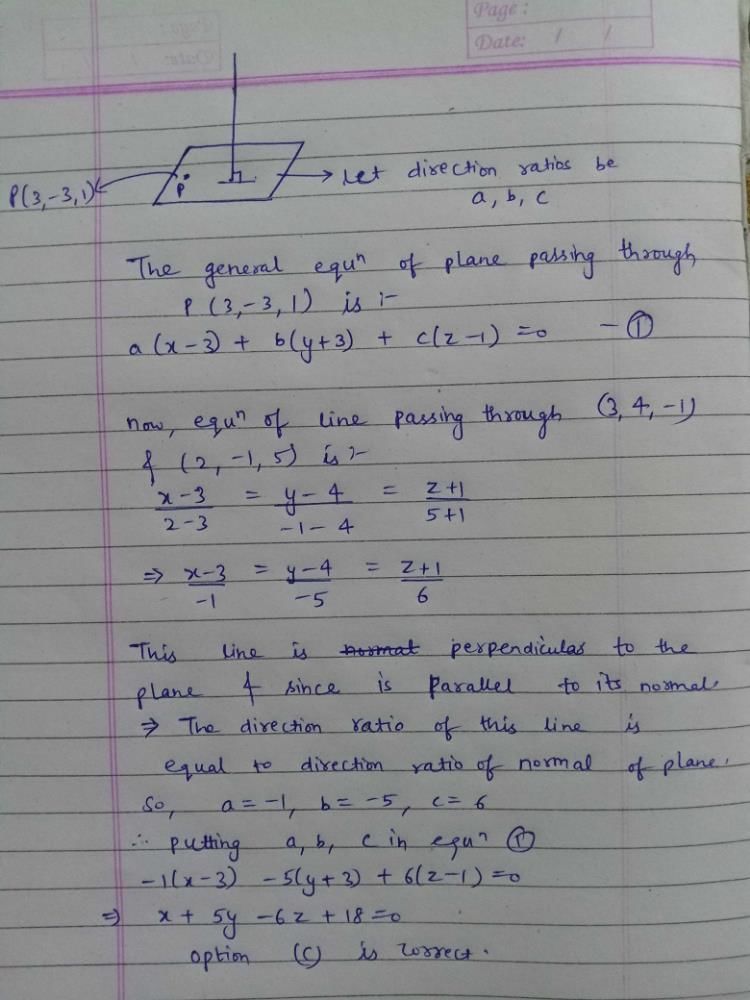
The angle between the lines x = 2y = – 3z and – 4x = 6y = – z is:- a)0°
- b)cos-1(1/√3)
- c)90°
- d)180°
Correct answer is option 'C'. Can you explain this answer?
The angle between the lines x = 2y = – 3z and – 4x = 6y = – z is:
a)
0°
b)
cos-1(1/√3)
c)
90°
d)
180°

|
Sushil Kumar answered |
x = 2y = -3z -4x = 6y = -z
x/1 = y/(½) = z(-⅓) x/(-¼) = y/(⅙) = z/(-1)
Cosθ = [(a1a2 + b1b2 + c1c2)/(a1 + b1 + c1)½ * (a2 + b2 + c2)½]
Cosθ ={[(1*(-¼)) + (½)(⅙) + (-⅓)(-1)]/[(1)2 + (½)2 + (-⅓)2]1/2 * [(-¼)2 + (⅙)2 + (-1)2]1/2}
= {[(-¼ + 1/12 - ⅓)]/[2 + 1 - ⅔]1/2 * [ -½ + ⅓ -½]½}
Cosθ = 0
θ = 90deg
x/1 = y/(½) = z(-⅓) x/(-¼) = y/(⅙) = z/(-1)
Cosθ = [(a1a2 + b1b2 + c1c2)/(a1 + b1 + c1)½ * (a2 + b2 + c2)½]
Cosθ ={[(1*(-¼)) + (½)(⅙) + (-⅓)(-1)]/[(1)2 + (½)2 + (-⅓)2]1/2 * [(-¼)2 + (⅙)2 + (-1)2]1/2}
= {[(-¼ + 1/12 - ⅓)]/[2 + 1 - ⅔]1/2 * [ -½ + ⅓ -½]½}
Cosθ = 0
θ = 90deg
The equation of the plane passing through the line of intersection of the planes x-2y+3z+8=0 and 2x-7y+4z-3=0 and the point (3, 1, -2) is:- a)6x-15y+12z+29=0
- b)6x-15y+16z+29=0
- c)6x-15y+12z+32=0
- d)2x-5y+4z+9=0
Correct answer is option 'B'. Can you explain this answer?
The equation of the plane passing through the line of intersection of the planes x-2y+3z+8=0 and 2x-7y+4z-3=0 and the point (3, 1, -2) is:
a)
6x-15y+12z+29=0
b)
6x-15y+16z+29=0
c)
6x-15y+12z+32=0
d)
2x-5y+4z+9=0
|
|
Tejas Verma answered |
(x - 2y + 3z + 8) + μ(2x - 7y + 4z - 3) = 0
i.e, (1 + 2μ)x - (2 + 7μ)y + (3 + 4μ)z + (8 - 3μ) = 0......(1)
the required plane is passing through (3, 1, -2)
so, 3(1 + 2μ) - (1)(2 + 7μ) + (-2)(3 + 4μ)+ (8 - 3μ) = 0
3 + 6μ - 2 - 7μ -6 -8μ + 8 - 3μ = 0
by solving, μ = 1/4
putting μ in equation (1)
we get the required equation of plane as :- 6x - 15y + 16z + 29 = 0
i.e, (1 + 2μ)x - (2 + 7μ)y + (3 + 4μ)z + (8 - 3μ) = 0......(1)
the required plane is passing through (3, 1, -2)
so, 3(1 + 2μ) - (1)(2 + 7μ) + (-2)(3 + 4μ)+ (8 - 3μ) = 0
3 + 6μ - 2 - 7μ -6 -8μ + 8 - 3μ = 0
by solving, μ = 1/4
putting μ in equation (1)
we get the required equation of plane as :- 6x - 15y + 16z + 29 = 0
If a line has the direction ratios -4, 18, -12 then what are its direction cosines?- a)-2, 9, -6
- b)-4, 18, -12
- c)2/11, 9/11, 6/11
- d)-2/11, 9/11, -6/11
Correct answer is option 'D'. Can you explain this answer?
If a line has the direction ratios -4, 18, -12 then what are its direction cosines?
a)
-2, 9, -6
b)
-4, 18, -12
c)
2/11, 9/11, 6/11
d)
-2/11, 9/11, -6/11
|
|
Vikas Kapoor answered |
DR of the line : (-4, 18 -12)
DC of the line : (-4/k, 18/k, -12/k)
where k = ((42) + (182) + (12)2)1/2
= (16 + 324 + 144)1/2
= (484)1/2
= 22
So, DC : (-4/22, 18/22, -12/22)
: (-2/11 , 9/11 , -6/11)
DC of the line : (-4/k, 18/k, -12/k)
where k = ((42) + (182) + (12)2)1/2
= (16 + 324 + 144)1/2
= (484)1/2
= 22
So, DC : (-4/22, 18/22, -12/22)
: (-2/11 , 9/11 , -6/11)
The Cartesian form of the equation of the plane  is:
is:- a)2x+3y-z=10
- b)2x+3y-z= √14
- c)2x+3y-z+√14=0
- d)2x+3y-z+10=0
Correct answer is option 'A'. Can you explain this answer?
The Cartesian form of the equation of the plane  is:
is:
a)
2x+3y-z=10
b)
2x+3y-z= √14
c)
2x+3y-z+√14=0
d)
2x+3y-z+10=0
|
|
Deepak Kapoor answered |
Let r = xi + yj + zk
(xi + yj + zk) . (2i + 3j - k) = 10
2x + 3y - k = 10
If a line makes angles 45°,150°, 135°, with x, y and z-axes respectively, find its direction cosines.- a)

- b)

- c)

- d)

Correct answer is option 'B'. Can you explain this answer?
If a line makes angles 45°,150°, 135°, with x, y and z-axes respectively, find its direction cosines.
a)
b)
c)
d)
|
|
Leelu Bhai answered |
Direction cosines of this line are cos 45, cos150 & cos135....i.e, 1/√2, -√3/2 & -1/√2
The length of the perpendicular from the origin to the plane 3x + 2y – 6z = 21 is:- a)3
- b)14
- c)21
- d)7
Correct answer is option 'A'. Can you explain this answer?
The length of the perpendicular from the origin to the plane 3x + 2y – 6z = 21 is:
a)
3
b)
14
c)
21
d)
7
|
|
Leelu Bhai answered |
Given equation of plane is : 3x + 2y - 6z - 21= 0
the length of perpendicular from a given point
(x' , y', z') on a plane ax + by + cz + d = 0 is given as :-
d = modulus of [{ax' + by' + cz' + d}/{√(a² + b² + c)²}]
so, d = modulus of [{(3*0) + (2*0) + (-6*0) + (-21)}/{√(3² + 2² + (-6)²)}]
d= modulus of (-21/√49) = (-21/7) = 3 units
hence option A is correct....
the length of perpendicular from a given point
(x' , y', z') on a plane ax + by + cz + d = 0 is given as :-
d = modulus of [{ax' + by' + cz' + d}/{√(a² + b² + c)²}]
so, d = modulus of [{(3*0) + (2*0) + (-6*0) + (-21)}/{√(3² + 2² + (-6)²)}]
d= modulus of (-21/√49) = (-21/7) = 3 units
hence option A is correct....
The equation of plane through the intersection of planes (x+y+z =1) and (2x +3y – z+4) =0 is- a)x(1 + 2k) + y(1 + 3k) + z(1 – k) + (-1 + 4k) = 0
- b)x(1+2k)+y(1-3k)+z(1-k)+(-1+4k) = 0
- c)x(1+2k) +y(1+3k)+z(1-k) +(-1 – 4k) = 0
- d)x (1-2k) + y(1+3k) +z(1-k) +(-1+4k) = 0
Correct answer is option 'A'. Can you explain this answer?
The equation of plane through the intersection of planes (x+y+z =1) and (2x +3y – z+4) =0 is
a)
x(1 + 2k) + y(1 + 3k) + z(1 – k) + (-1 + 4k) = 0
b)
x(1+2k)+y(1-3k)+z(1-k)+(-1+4k) = 0
c)
x(1+2k) +y(1+3k)+z(1-k) +(-1 – 4k) = 0
d)
x (1-2k) + y(1+3k) +z(1-k) +(-1+4k) = 0
|
|
Kritika Sarkar answered |
To find the equation of the plane through the intersection of two given planes, we need to first determine the line of intersection and then find a normal vector for the plane.
1. Finding the line of intersection:
The two given planes are:
Plane 1: x + y + z = 1
Plane 2: 2x + 3y + z + 4 = 0
To find the line of intersection, we can set the equations of the two planes equal to each other:
x + y + z = 1
2x + 3y + z + 4 = 0
By subtracting the second equation from the first equation, we can eliminate z:
x + y + z - (2x + 3y + z + 4) = 1 - 0
-x - 2y - 4 = -1
Simplifying the equation, we get:
x + 2y = 3
This equation represents the line of intersection of the two planes.
2. Finding a normal vector for the plane:
Since the line of intersection lies on both planes, the normal vector of the required plane should be perpendicular to this line. Therefore, we can choose the direction ratios of the line, -1 and 2, as coefficients of the normal vector.
The normal vector of the required plane is given by the cross product of the direction ratios of the line of intersection:
n = (1, 2, 0) x (-1, 2, 0) = (0, 0, -4)
3. Writing the equation of the plane:
Now we have a point on the plane, (1, 0, 0), and a normal vector, (0, 0, -4). We can use the point-normal form of the equation of a plane to write the equation of the required plane.
The equation of the plane is given by:
0(x - 1) + 0(y - 0) + (-4)(z - 0) = 0
Simplifying the equation, we get:
-4z + 4 = 0
z = 1
Therefore, the equation of the plane through the intersection of the given planes is:
x + 2y - 4z + 4 = 0
Comparing this equation with the options provided, we see that option A is the correct answer:
x(1 2k) + y(1 3k) + z(1 k) + (-1 4k) = 0
1. Finding the line of intersection:
The two given planes are:
Plane 1: x + y + z = 1
Plane 2: 2x + 3y + z + 4 = 0
To find the line of intersection, we can set the equations of the two planes equal to each other:
x + y + z = 1
2x + 3y + z + 4 = 0
By subtracting the second equation from the first equation, we can eliminate z:
x + y + z - (2x + 3y + z + 4) = 1 - 0
-x - 2y - 4 = -1
Simplifying the equation, we get:
x + 2y = 3
This equation represents the line of intersection of the two planes.
2. Finding a normal vector for the plane:
Since the line of intersection lies on both planes, the normal vector of the required plane should be perpendicular to this line. Therefore, we can choose the direction ratios of the line, -1 and 2, as coefficients of the normal vector.
The normal vector of the required plane is given by the cross product of the direction ratios of the line of intersection:
n = (1, 2, 0) x (-1, 2, 0) = (0, 0, -4)
3. Writing the equation of the plane:
Now we have a point on the plane, (1, 0, 0), and a normal vector, (0, 0, -4). We can use the point-normal form of the equation of a plane to write the equation of the required plane.
The equation of the plane is given by:
0(x - 1) + 0(y - 0) + (-4)(z - 0) = 0
Simplifying the equation, we get:
-4z + 4 = 0
z = 1
Therefore, the equation of the plane through the intersection of the given planes is:
x + 2y - 4z + 4 = 0
Comparing this equation with the options provided, we see that option A is the correct answer:
x(1 2k) + y(1 3k) + z(1 k) + (-1 4k) = 0
Direction: Read the following text and answer the following questions on the basis of the same:A mobile tower stands at the top of a hill. Consider the surface on which the tower stands as a plane having points A(1, 0, 2), B(3, –1, 1) and C(1, 2, 1) on it. The mobile tower is tied with 3 cables from the points A, B and C such that it stands vertically on the ground. The top of the tower is at the point (2, 3, 1) as shown in the figure.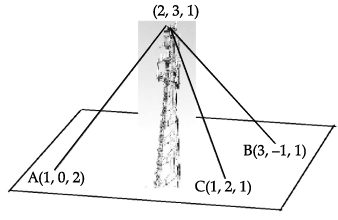 Q. The equation of the plane passing through the points A, B and C is
Q. The equation of the plane passing through the points A, B and C is- a)3x – 2y + 4z = –11
- b)3x + 2y + 4z = 11
- c)3x – 2y – 4z = 11
- d)–3x + 2y + 4z = –11
Correct answer is option 'B'. Can you explain this answer?
Direction: Read the following text and answer the following questions on the basis of the same:
A mobile tower stands at the top of a hill. Consider the surface on which the tower stands as a plane having points A(1, 0, 2), B(3, –1, 1) and C(1, 2, 1) on it. The mobile tower is tied with 3 cables from the points A, B and C such that it stands vertically on the ground. The top of the tower is at the point (2, 3, 1) as shown in the figure.

Q. The equation of the plane passing through the points A, B and C is
a)
3x – 2y + 4z = –11
b)
3x + 2y + 4z = 11
c)
3x – 2y – 4z = 11
d)
–3x + 2y + 4z = –11
|
|
Krishna Iyer answered |
A(1, 0, 2), B(3, –1, 1) and C(1, 2, 1)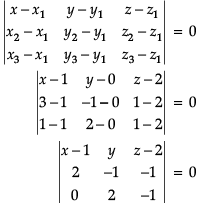

(x - 1)(1 + 2) -y (-2, 0) + (z - 2) (4 - 0)
3x - 3 + 2y + 4z - 8 = 0
3x + 2y + 4z = 11
Find the direction cosines of the x axis.- a)1, 0, 0
- b)0, 0, 0
- c)0, 1, 0
- d)0, 0, 1
Correct answer is option 'A'. Can you explain this answer?
Find the direction cosines of the x axis.
a)
1, 0, 0
b)
0, 0, 0
c)
0, 1, 0
d)
0, 0, 1
|
|
Ishan Choudhury answered |
To find Direction Cosines of X-axis.
Take any two points on X-axis : A(a,0,0) & B(b,0,0)
DR of AB : (b-a,0,0)
DC of AB : ((b-a)/(((b-a)2 + 0 + 0)1/2), 0, 0)
: ((b-a)/(b-a) , 0 , 0)
: (1,0,0)
Take any two points on X-axis : A(a,0,0) & B(b,0,0)
DR of AB : (b-a,0,0)
DC of AB : ((b-a)/(((b-a)2 + 0 + 0)1/2), 0, 0)
: ((b-a)/(b-a) , 0 , 0)
: (1,0,0)
In the following case, determine whether the given planes are parallel or perpendicular, and in case they are neither, find the angles between them. 2x – 2y + 4z + 5 = 0 and 3x – 3y + 6z – 1 = 0- a)The planes are perpendicular
- b)The planes are parallel
- c)The planes are at 45∘
- d)The planes are at 55∘
Correct answer is option 'B'. Can you explain this answer?
In the following case, determine whether the given planes are parallel or perpendicular, and in case they are neither, find the angles between them. 2x – 2y + 4z + 5 = 0 and 3x – 3y + 6z – 1 = 0
a)
The planes are perpendicular
b)
The planes are parallel
c)
The planes are at 45∘
d)
The planes are at 55∘

|
Pranavi Iyer answered |
The equation of the plane, which is at a distance of 5 unit from the origin and has  as a normal vector, is:
as a normal vector, is:- a)

- b)

- c)

- d)

Correct answer is option 'D'. Can you explain this answer?
The equation of the plane, which is at a distance of 5 unit from the origin and has  as a normal vector, is:
as a normal vector, is:
a)
b)
c)
d)
|
|
Preeti Iyer answered |
x = 3i - 2j - 6k
|x| = ((3)2 + (2)2 + (6)2)
|x| = (49)½
|x| = 7
x = x/|x|
= (3i - 2j - 6k)/7
The required equation of plane is r.x = d
⇒ r.(3i - 2j - 6k)/7 = 5
⇒ r.(3i - 2j - 6k) = 35
|x| = ((3)2 + (2)2 + (6)2)
|x| = (49)½
|x| = 7
x = x/|x|
= (3i - 2j - 6k)/7
The required equation of plane is r.x = d
⇒ r.(3i - 2j - 6k)/7 = 5
⇒ r.(3i - 2j - 6k) = 35
For which value of a lines  and
and  are perpendicular?
are perpendicular?
- a)11/70
- b)5
- c)1
- d)70/11
Correct answer is option 'B'. Can you explain this answer?
For which value of a lines  and
and  are perpendicular?
are perpendicular?
a)
11/70
b)
5
c)
1
d)
70/11
|
|
Tejas Verma answered |
(x-1)/(-3) = (y-2)/(2p/7) = (z-3)/2
(x-1)(-3p/7) = (y - 5)/1 = (z - 6)/(-5)
The direction ratio of the line are -3, 2p/7, -2 and (-3p)/7, 1, -5
Two lines with direction ratios, a1, b1, c1 and a2, b2, c2 are perpendicular to each other if a1a2 + b1b2 + c1c2 = 0
Therefore, (-3)(-3p/7) + (2p/7)(1) + 2(-5) = 0
(9p/7) + (2p/7) = 10
11p = 70
p = 70/1
(x-1)(-3p/7) = (y - 5)/1 = (z - 6)/(-5)
The direction ratio of the line are -3, 2p/7, -2 and (-3p)/7, 1, -5
Two lines with direction ratios, a1, b1, c1 and a2, b2, c2 are perpendicular to each other if a1a2 + b1b2 + c1c2 = 0
Therefore, (-3)(-3p/7) + (2p/7)(1) + 2(-5) = 0
(9p/7) + (2p/7) = 10
11p = 70
p = 70/1
The equation of the plane passing through the point (3, – 3, 1) and perpendicular to the line joining the points (3, 4, – 1) and (2, – 1, 5) is:- a)– x – 5y + 6z + 18 = 0
- b)x – 5y + 6z + 18 = 0
- c)x + 5y – 6z + 18 = 0
- d)– x – 5y – 6z + 18 = 0
Correct answer is option 'C'. Can you explain this answer?
The equation of the plane passing through the point (3, – 3, 1) and perpendicular to the line joining the points (3, 4, – 1) and (2, – 1, 5) is:
a)
– x – 5y + 6z + 18 = 0
b)
x – 5y + 6z + 18 = 0
c)
x + 5y – 6z + 18 = 0
d)
– x – 5y – 6z + 18 = 0
|
|
Preeti Iyer answered |
The equation of the plane passing through the point (3, – 3, 1) is:
a(x – 3) + b(y + 3) + c(z – 1) = 0 and the direction ratios of the line joining the points
(3, 4, – 1) and (2, – 1, 5) is 2 – 3, – 1 – 4, 5 + 1, i.e., – 1, – 5, 6.
Since the plane is perpendicular to the line whose direction ratios are – 1, – 5, 6, therefore, direction ratios of the normal to the plane is – 1, – 5, 6.
So, required equation of plane is: – 1(x – 3) – 5(y + 3) + 6(z – 1) = 0
i.e., x + 5y – 6z + 18 = 0.
a(x – 3) + b(y + 3) + c(z – 1) = 0 and the direction ratios of the line joining the points
(3, 4, – 1) and (2, – 1, 5) is 2 – 3, – 1 – 4, 5 + 1, i.e., – 1, – 5, 6.
Since the plane is perpendicular to the line whose direction ratios are – 1, – 5, 6, therefore, direction ratios of the normal to the plane is – 1, – 5, 6.
So, required equation of plane is: – 1(x – 3) – 5(y + 3) + 6(z – 1) = 0
i.e., x + 5y – 6z + 18 = 0.
Direction: Read the following text and answer the following questions on the basis of the same:The Indian coast guard, while patrolling, saw a suspicious boat with people. They were nowhere looking like fishermen. The coast guard were closely observing the movement of the boat for an opportunity to seize the boat. They observed that the boat is moving along a planar surface. At an instant of time, the coordinates of the position of the coast guard helicopter and the boat is (1, 3, 5) and (2, 5, 3) respectively. Q. If the coast guard decides to shoot the boat at that given instant of time, when the speed of bullet is 36 m/sec, then what is the time taken for the bullet to travel and hit the boat?
Q. If the coast guard decides to shoot the boat at that given instant of time, when the speed of bullet is 36 m/sec, then what is the time taken for the bullet to travel and hit the boat?- a)1/8 second
- b)1/14 second
- c)1/10 second
- d)1/12 second
Correct answer is option 'D'. Can you explain this answer?
Direction: Read the following text and answer the following questions on the basis of the same:
The Indian coast guard, while patrolling, saw a suspicious boat with people. They were nowhere looking like fishermen. The coast guard were closely observing the movement of the boat for an opportunity to seize the boat. They observed that the boat is moving along a planar surface. At an instant of time, the coordinates of the position of the coast guard helicopter and the boat is (1, 3, 5) and (2, 5, 3) respectively.

Q. If the coast guard decides to shoot the boat at that given instant of time, when the speed of bullet is 36 m/sec, then what is the time taken for the bullet to travel and hit the boat?
a)
1/8 second
b)
1/14 second
c)
1/10 second
d)
1/12 second
|
|
Nandini Iyer answered |
Time taken for the bullet to travel and hit the boat

In the following case, determine whether the given planes are parallel orperpendicular, and in case they are neither, find the angles between them. 2x + y + 3z – 2 = 0 and x – 2y + 5 = 0- a)The planes are parallel
- b)The planes are at 45∘
- c)The planes are at 55∘
- d)The planes are perpendicular
Correct answer is option 'D'. Can you explain this answer?
In the following case, determine whether the given planes are parallel orperpendicular, and in case they are neither, find the angles between them. 2x + y + 3z – 2 = 0 and x – 2y + 5 = 0
a)
The planes are parallel
b)
The planes are at 45∘
c)
The planes are at 55∘
d)
The planes are perpendicular
|
|
Upasana Nambiar answered |
Understanding the Given Planes
To determine the relationship between the two planes, we need to first rewrite their equations in a standard format and extract the normal vectors.
Plane Equations
1. First Plane:
The equation is given as 2x + y + 3z - 2 = 0.
The normal vector (N1) can be derived from the coefficients:
N1 = (2, 1, 3).
2. Second Plane:
The equation is x - 2y + 5 = 0, which can be rewritten as x - 2y + 0z + 5 = 0.
The normal vector (N2) can be derived as:
N2 = (1, -2, 0).
Checking for Parallelism
- Two planes are parallel if their normal vectors are scalar multiples of each other.
- Here, N1 = (2, 1, 3) and N2 = (1, -2, 0) are not scalar multiples.
- Thus, the planes are not parallel.
Checking for Perpendicularity
- Two planes are perpendicular if the dot product of their normal vectors equals zero.
- We calculate the dot product:
N1 • N2 = (2)(1) + (1)(-2) + (3)(0) = 2 - 2 + 0 = 0.
- Since the dot product is zero, the planes are perpendicular.
Conclusion
The given planes are neither parallel nor at a specified angle; they are indeed perpendicular to each other. Thus, the correct answer is option 'D'.
To determine the relationship between the two planes, we need to first rewrite their equations in a standard format and extract the normal vectors.
Plane Equations
1. First Plane:
The equation is given as 2x + y + 3z - 2 = 0.
The normal vector (N1) can be derived from the coefficients:
N1 = (2, 1, 3).
2. Second Plane:
The equation is x - 2y + 5 = 0, which can be rewritten as x - 2y + 0z + 5 = 0.
The normal vector (N2) can be derived as:
N2 = (1, -2, 0).
Checking for Parallelism
- Two planes are parallel if their normal vectors are scalar multiples of each other.
- Here, N1 = (2, 1, 3) and N2 = (1, -2, 0) are not scalar multiples.
- Thus, the planes are not parallel.
Checking for Perpendicularity
- Two planes are perpendicular if the dot product of their normal vectors equals zero.
- We calculate the dot product:
N1 • N2 = (2)(1) + (1)(-2) + (3)(0) = 2 - 2 + 0 = 0.
- Since the dot product is zero, the planes are perpendicular.
Conclusion
The given planes are neither parallel nor at a specified angle; they are indeed perpendicular to each other. Thus, the correct answer is option 'D'.
Direction: Read the following text and answer the following questions on the basis of the same:A cricket match is organized between two Clubs A and B for which a team from each club is chosen. Remaining players of Club A and Club B are respectively sitting on the plane represented by the equation  to cheer the team of their own clubs.
to cheer the team of their own clubs. Q. The intercept form of the equation of the plane on which players of Club B are seated is
Q. The intercept form of the equation of the plane on which players of Club B are seated is- a)

- b)

- c)

- d)

Correct answer is option 'C'. Can you explain this answer?
Direction: Read the following text and answer the following questions on the basis of the same:
A cricket match is organized between two Clubs A and B for which a team from each club is chosen. Remaining players of Club A and Club B are respectively sitting on the plane represented by the equation  to cheer the team of their own clubs.
to cheer the team of their own clubs.
 to cheer the team of their own clubs.
to cheer the team of their own clubs.
Q. The intercept form of the equation of the plane on which players of Club B are seated is
a)

b)

c)

d)

|
|
Hansa Sharma answered |


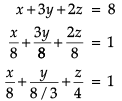
Find the equations of the planes that passes through three points (1, 1, 0), (1, 2, 1), (– 2, 2, – 1)- a)2x + 3y – 7z = 5
- b)2x + 5y – 3z = 5
- c)3x + 3y – 3z = 5
- d)2x + 3y – 3z = 5
Correct answer is option 'D'. Can you explain this answer?
Find the equations of the planes that passes through three points (1, 1, 0), (1, 2, 1), (– 2, 2, – 1)
a)
2x + 3y – 7z = 5
b)
2x + 5y – 3z = 5
c)
3x + 3y – 3z = 5
d)
2x + 3y – 3z = 5

|
Anand Khanna answered |
In cartesian co-ordinate system :
Equation of a plane passing through three non collinear
Equation of a plane passing through three non collinear
Points (x1, y1, z1) , (x2, y2, z2) and (x3, y3, z3) is given by :

Therefore, the equations of the planes that passes through three points (1,1,0), (1,2,1), (-2,2,-1) is given by :

⇒ (x-1)(-2) - (y-1) (3) + 3z = 0
⇒ 2x+3y - 3z = 5

Therefore, the equations of the planes that passes through three points (1,1,0), (1,2,1), (-2,2,-1) is given by :

⇒ (x-1)(-2) - (y-1) (3) + 3z = 0
⇒ 2x+3y - 3z = 5
Find the equation of the plane through the line of intersection of the planes x + y + z = 1 and 2x + 3y + 4z = 5 which is perpendicular to the plane x – y + z = 0.- a)x + z + 2 = 0
- b)– x – z + 2 = 0
- c)x – z + 2 = 0
- d)x + z + 5 = 0
Correct answer is option 'C'. Can you explain this answer?
Find the equation of the plane through the line of intersection of the planes x + y + z = 1 and 2x + 3y + 4z = 5 which is perpendicular to the plane x – y + z = 0.
a)
x + z + 2 = 0
b)
– x – z + 2 = 0
c)
x – z + 2 = 0
d)
x + z + 5 = 0

|
Avi Chawla answered |
The equation of the plane through the line of intersection of the planes







Direction: Read the following text and answer the following questions on the basis of the same:A cricket match is organized between two Clubs A and B for which a team from each club is chosen. Remaining players of Club A and Club B are respectively sitting on the plane represented by the equation  to cheer the team of their own clubs.
to cheer the team of their own clubs. Q. The distance of the plane, on which players of Club B are seated, from the origin is
Q. The distance of the plane, on which players of Club B are seated, from the origin is- a)

- b)

- c)

- d)

Correct answer is option 'A'. Can you explain this answer?
Direction: Read the following text and answer the following questions on the basis of the same:
A cricket match is organized between two Clubs A and B for which a team from each club is chosen. Remaining players of Club A and Club B are respectively sitting on the plane represented by the equation  to cheer the team of their own clubs.
to cheer the team of their own clubs.
 to cheer the team of their own clubs.
to cheer the team of their own clubs.
Q. The distance of the plane, on which players of Club B are seated, from the origin is
a)

b)

c)

d)


|
Pioneer Academy answered |
We know

∴ 

∴ 

The angle between two lines whose direction ratios are 1,2,1 and 2,-3,4 is:- a)30°
- b)60°
- c)90°
- d)45°
Correct answer is option 'C'. Can you explain this answer?
The angle between two lines whose direction ratios are 1,2,1 and 2,-3,4 is:
a)
30°
b)
60°
c)
90°
d)
45°

|
O Kaif Sid answered |
Cosx =( i+2j+k).(2i-3j+4k)/ √1+4+1 × √4+9+16
cosx= 2-6+4/√1+4+1 × √4+9+16
cosx = 0/√1+4+1 × √4+9+16
cosx = 0
therfore
x = 90
cosx= 2-6+4/√1+4+1 × √4+9+16
cosx = 0/√1+4+1 × √4+9+16
cosx = 0
therfore
x = 90
Find the distance of the point (0, 0, 0) from the plane 3x – 4y + 12 z = 3- a)9/13
- b)7/13
- c)5/13
- d)3/13
Correct answer is option 'D'. Can you explain this answer?
Find the distance of the point (0, 0, 0) from the plane 3x – 4y + 12 z = 3
a)
9/13
b)
7/13
c)
5/13
d)
3/13

|
Krish Ghoshal answered |
As we know that the length of the perpendicular from point
P(x1,y1,z1) from the plane a1x+b1y+c1z+d1 = 0 is given by:

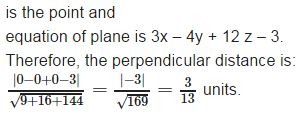
P(x1,y1,z1) from the plane a1x+b1y+c1z+d1 = 0 is given by:
Direction: Read the following text and answer the following questions on the basis of the same:The equation of motion of a missile are x = 3t, y = –4t, z = t, where the time ‘t’ is given in seconds, and the distance is measured in kilometres. Q. At what distance will the rocket be from the starting point (0, 0, 0) in 5 seconds?
Q. At what distance will the rocket be from the starting point (0, 0, 0) in 5 seconds?- a)

- b)

- c)

- d)

Correct answer is option 'B'. Can you explain this answer?
Direction: Read the following text and answer the following questions on the basis of the same:
The equation of motion of a missile are x = 3t, y = –4t, z = t, where the time ‘t’ is given in seconds, and the distance is measured in kilometres.

Q. At what distance will the rocket be from the starting point (0, 0, 0) in 5 seconds?
a)

b)

c)

d)


|
Cstoppers Instructors answered |
Here,
t = 5 seconds
x = 3t = 3 x 5 = 15
y = -4t = -4 x 5 = -20
z = t = 5
(x, y, z) (15, -20, 5)
Distance from starting point(0, 0, 0)

Find the direction cosines of a line which makes equal angles with all three the coordinate axes.- a)± 1/√2, ± 1/√2, ± 1/√2
- b)1/√3, 1/√3, 1/√3
- c)1/√2, 1/√2, 1/√2
- d)± 1/√3, ± 1/√3, ± 1/√3
Correct answer is option 'D'. Can you explain this answer?
Find the direction cosines of a line which makes equal angles with all three the coordinate axes.
a)
± 1/√2, ± 1/√2, ± 1/√2
b)
1/√3, 1/√3, 1/√3
c)
1/√2, 1/√2, 1/√2
d)
± 1/√3, ± 1/√3, ± 1/√3
|
|
Sakshi Shah answered |
Understanding Direction Cosines
Direction cosines are the cosines of the angles that a line makes with the coordinate axes. For a line to make equal angles with all three axes, the direction cosines must be equal in magnitude.
Equal Angles with Axes
If a line makes equal angles with the x, y, and z axes, then we can denote the direction cosines as:
- l = cos(α)
- m = cos(β)
- n = cos(γ)
Where α, β, and γ are the angles with the x, y, and z axes, respectively.
Since the angles are equal, we have:
- l = m = n
Magnitude Condition
The sum of the squares of the direction cosines must equal 1:
- l² + m² + n² = 1
Substituting l = m = n gives:
- 3l² = 1
- l² = 1/3
- l = ±1/√3
Thus, the direction cosines can be expressed as:
- l = ±1/√3
- m = ±1/√3
- n = ±1/√3
Conclusion
The direction cosines that make equal angles with the coordinate axes are:
- ±1/√3, ±1/√3, ±1/√3
This corresponds to option 'D':
- Direction cosines: ±1/√3, ±1/√3, ±1/√3
Therefore, the correct answer is indeed option 'D'.
Direction cosines are the cosines of the angles that a line makes with the coordinate axes. For a line to make equal angles with all three axes, the direction cosines must be equal in magnitude.
Equal Angles with Axes
If a line makes equal angles with the x, y, and z axes, then we can denote the direction cosines as:
- l = cos(α)
- m = cos(β)
- n = cos(γ)
Where α, β, and γ are the angles with the x, y, and z axes, respectively.
Since the angles are equal, we have:
- l = m = n
Magnitude Condition
The sum of the squares of the direction cosines must equal 1:
- l² + m² + n² = 1
Substituting l = m = n gives:
- 3l² = 1
- l² = 1/3
- l = ±1/√3
Thus, the direction cosines can be expressed as:
- l = ±1/√3
- m = ±1/√3
- n = ±1/√3
Conclusion
The direction cosines that make equal angles with the coordinate axes are:
- ±1/√3, ±1/√3, ±1/√3
This corresponds to option 'D':
- Direction cosines: ±1/√3, ±1/√3, ±1/√3
Therefore, the correct answer is indeed option 'D'.
Direction: Read the following text and answer the following questions on the basis of the same:A cricket match is organized between two Clubs A and B for which a team from each club is chosen. Remaining players of Club A and Club B are respectively sitting on the plane represented by the equation  to cheer the team of their own clubs.
to cheer the team of their own clubs. Q. The Cartesian equation of the plane on which players of Club A are seated is
Q. The Cartesian equation of the plane on which players of Club A are seated is- a)2x − y + z = 3
- b)2x − y + 2z = 3
- c)2x − y + z =−3
- d)x − t + z = 3
Correct answer is option 'A'. Can you explain this answer?
Direction: Read the following text and answer the following questions on the basis of the same:
A cricket match is organized between two Clubs A and B for which a team from each club is chosen. Remaining players of Club A and Club B are respectively sitting on the plane represented by the equation  to cheer the team of their own clubs.
to cheer the team of their own clubs.
 to cheer the team of their own clubs.
to cheer the team of their own clubs.
Q. The Cartesian equation of the plane on which players of Club A are seated is
a)
2x − y + z = 3
b)
2x − y + 2z = 3
c)
2x − y + z =−3
d)
x − t + z = 3
|
|
Anjali Sharma answered |



2x - y + z = 3
Three planes, viz the XY Plane, XZ Plane and the YZ Plane divide the space into eight parts. Each part is called an OCTANT. What is the relation between these three planes- a)They form the angles α, β & γ with each other
- b)Any two must be perpendicular to each other.
- c)All three are mutually perpendicular
- d)no relation between these three planes
Correct answer is option 'C'. Can you explain this answer?
Three planes, viz the XY Plane, XZ Plane and the YZ Plane divide the space into eight parts. Each part is called an OCTANT. What is the relation between these three planes
a)
They form the angles α, β & γ with each other
b)
Any two must be perpendicular to each other.
c)
All three are mutually perpendicular
d)
no relation between these three planes
|
|
Janani Pillai answered |
The three mutually perpendicular coordinate planes which in turn divide the space into eight parts and each part is known as octant.
The direction cosines of the line equally inclined with the axes, are:- a)1, 1, 1,
- b)0, 0, 0
- c)1/3, 1/3, 1/3
- d)1/√3, 1/√3, 1/√3
Correct answer is option 'D'. Can you explain this answer?
The direction cosines of the line equally inclined with the axes, are:
a)
1, 1, 1,
b)
0, 0, 0
c)
1/3, 1/3, 1/3
d)
1/√3, 1/√3, 1/√3
|
|
Geetika Mehta answered |
Direction cosines are the ratios of the direction ratios of a line. In other words, they represent the cosines of the angles that the line makes with the positive x, y, and z axes.
Let's consider a line equally inclined with the axes. This means that the line makes equal angles with each axis.
To find the direction cosines of this line, we need to determine the cosines of the angles it makes with the x, y, and z axes.
Let's assume that the line makes an angle of θ with each axis. Since the line is equally inclined with the axes, all the angles are equal.
Let's calculate the direction cosine along the x-axis:
cos(θ) = adjacent side / hypotenuse
cos(θ) = 1 / hypotenuse
hypotenuse = 1 / cos(θ)
Similarly, the direction cosine along the y-axis and z-axis would also be 1 / cos(θ).
Therefore, the direction cosines of the line equally inclined with the axes are (1 / cos(θ), 1 / cos(θ), 1 / cos(θ)).
Since the line is equally inclined with the axes, the angle θ is the same for all three direction cosines.
Hence, the correct answer is option D: 1/3, 1/3, 1/3.
Let's consider a line equally inclined with the axes. This means that the line makes equal angles with each axis.
To find the direction cosines of this line, we need to determine the cosines of the angles it makes with the x, y, and z axes.
Let's assume that the line makes an angle of θ with each axis. Since the line is equally inclined with the axes, all the angles are equal.
Let's calculate the direction cosine along the x-axis:
cos(θ) = adjacent side / hypotenuse
cos(θ) = 1 / hypotenuse
hypotenuse = 1 / cos(θ)
Similarly, the direction cosine along the y-axis and z-axis would also be 1 / cos(θ).
Therefore, the direction cosines of the line equally inclined with the axes are (1 / cos(θ), 1 / cos(θ), 1 / cos(θ)).
Since the line is equally inclined with the axes, the angle θ is the same for all three direction cosines.
Hence, the correct answer is option D: 1/3, 1/3, 1/3.
Direction: Read the following text and answer the following questions on the basis of the same:The Indian coast guard, while patrolling, saw a suspicious boat with people. They were nowhere looking like fishermen. The coast guard were closely observing the movement of the boat for an opportunity to seize the boat. They observed that the boat is moving along a planar surface. At an instant of time, the coordinates of the position of the coast guard helicopter and the boat is (1, 3, 5) and (2, 5, 3) respectively. Q. At that given instant of time, the equation of line passing through the positions of the helicopter and boat is
Q. At that given instant of time, the equation of line passing through the positions of the helicopter and boat is- a)

- b)

- c)

- d)

Correct answer is option 'A'. Can you explain this answer?
Direction: Read the following text and answer the following questions on the basis of the same:
The Indian coast guard, while patrolling, saw a suspicious boat with people. They were nowhere looking like fishermen. The coast guard were closely observing the movement of the boat for an opportunity to seize the boat. They observed that the boat is moving along a planar surface. At an instant of time, the coordinates of the position of the coast guard helicopter and the boat is (1, 3, 5) and (2, 5, 3) respectively.

Q. At that given instant of time, the equation of line passing through the positions of the helicopter and boat is
a)

b)

c)

d)


|
Top Rankers answered |
Here, direction cosines are 1, 2, –2.

Equation of line passing through the positions of the helicopter and boat is

⇒ 


Angle between skew lines is- a)the angle between two non intersecting lines drawn from any point parallel to each of the skew lines
- b)the angle between two intersecting lines drawn from any point perpendicular to each of the skew lines
- c)the angle between two non intersecting lines drawn from any point anti – parallel to each of the skew lines
- d)the angle between two intersecting lines drawn from any point parallel to each of the skew lines
Correct answer is option 'D'. Can you explain this answer?
Angle between skew lines is
a)
the angle between two non intersecting lines drawn from any point parallel to each of the skew lines
b)
the angle between two intersecting lines drawn from any point perpendicular to each of the skew lines
c)
the angle between two non intersecting lines drawn from any point anti – parallel to each of the skew lines
d)
the angle between two intersecting lines drawn from any point parallel to each of the skew lines

|
Rhea Joshi answered |
Understanding Skew Lines
Skew lines are non-parallel lines that do not intersect and exist in different planes. To find the angle between skew lines, we need to adopt a specific approach.
Correct Option: D
The correct answer is option 'D': the angle between two intersecting lines drawn from any point parallel to each of the skew lines. Here’s why this is the case:
Angle Definition
- The angle between two lines is typically defined using the lines' directions or their projections onto a common plane.
- For skew lines, we cannot directly measure the angle as they do not meet.
Using Parallel Lines to Determine Angle
- By drawing lines from a common point that are parallel to each of the skew lines, we create a scenario where the angle between these lines can be calculated conveniently.
- These auxiliary lines will intersect, allowing us to measure the angle formed.
Geometric Interpretation
- Imagine placing a point in space from which you can draw one line parallel to each skew line.
- The intersection of these two lines gives you a clear angle, which represents the angle between the original skew lines.
Why Other Options Are Incorrect
- Option A: Non-intersecting lines do not provide a defined angle measurement.
- Option B: Perpendicular lines do not relate to the original skew lines.
- Option C: Anti-parallel lines do not help in defining the angle between skew lines.
In conclusion, option 'D' is the correct choice as it efficiently utilizes the concept of parallel lines to determine the angle between skew lines through their intersection. This approach simplifies the understanding of angles in three-dimensional space.
Skew lines are non-parallel lines that do not intersect and exist in different planes. To find the angle between skew lines, we need to adopt a specific approach.
Correct Option: D
The correct answer is option 'D': the angle between two intersecting lines drawn from any point parallel to each of the skew lines. Here’s why this is the case:
Angle Definition
- The angle between two lines is typically defined using the lines' directions or their projections onto a common plane.
- For skew lines, we cannot directly measure the angle as they do not meet.
Using Parallel Lines to Determine Angle
- By drawing lines from a common point that are parallel to each of the skew lines, we create a scenario where the angle between these lines can be calculated conveniently.
- These auxiliary lines will intersect, allowing us to measure the angle formed.
Geometric Interpretation
- Imagine placing a point in space from which you can draw one line parallel to each skew line.
- The intersection of these two lines gives you a clear angle, which represents the angle between the original skew lines.
Why Other Options Are Incorrect
- Option A: Non-intersecting lines do not provide a defined angle measurement.
- Option B: Perpendicular lines do not relate to the original skew lines.
- Option C: Anti-parallel lines do not help in defining the angle between skew lines.
In conclusion, option 'D' is the correct choice as it efficiently utilizes the concept of parallel lines to determine the angle between skew lines through their intersection. This approach simplifies the understanding of angles in three-dimensional space.
Equation of a plane which is at a distance d from the origin and the direction cosines of the normal to the plane are l, m, n is.- a)lx – my + nz = d
- b)– lx + my + nz = d
- c)lx + my + nz = d
- d)lx + my + nz = – d
Correct answer is option 'C'. Can you explain this answer?
Equation of a plane which is at a distance d from the origin and the direction cosines of the normal to the plane are l, m, n is.
a)
lx – my + nz = d
b)
– lx + my + nz = d
c)
lx + my + nz = d
d)
lx + my + nz = – d

|
Aravind Nambiar answered |
In Cartesian co – ordinate system Equation of a plane which is at a distance d from the origin and the direction cosines of the normal to the plane are l, m, n is given by : lx + my + nz = d.
Direction: Read the following text and answer the following questions on the basis of the same:Consider the plane π1 : 2x – 3y + 4z + 9 = 0 and the point P(1, –2, 3). π1 is a plane parallel to π1 and containing the point P.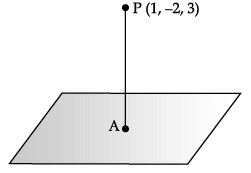 Q. Distance between π1 and π2 is _______ units.
Q. Distance between π1 and π2 is _______ units.- a)5
- b)

- c)

- d)2√3
Correct answer is option 'B'. Can you explain this answer?
Direction: Read the following text and answer the following questions on the basis of the same:
Consider the plane π1 : 2x – 3y + 4z + 9 = 0 and the point P(1, –2, 3). π1 is a plane parallel to π1 and containing the point P.

Q. Distance between π1 and π2 is _______ units.
a)
5
b)

c)

d)
2√3
|
|
Swati Verma answered |
Distance between π1 and π2

Chapter doubts & questions for Chapter 11 - Three Dimensional Geometry - Mathematics CUET UG Mock Test Series 2026 2025 is part of JEE exam preparation. The chapters have been prepared according to the JEE exam syllabus. The Chapter doubts & questions, notes, tests & MCQs are made for JEE 2025 Exam. Find important definitions, questions, notes, meanings, examples, exercises, MCQs and online tests here.
Chapter doubts & questions of Chapter 11 - Three Dimensional Geometry - Mathematics CUET UG Mock Test Series 2026 in English & Hindi are available as part of JEE exam.
Download more important topics, notes, lectures and mock test series for JEE Exam by signing up for free.
Related JEE Content

Contact Support
Our team is online on weekdays between 10 AM - 7 PM
Typical reply within 3 hours
|
Free Exam Preparation
at your Fingertips!
Access Free Study Material - Test Series, Structured Courses, Free Videos & Study Notes and Prepare for Your Exam With Ease

 Join the 10M+ students on EduRev
Join the 10M+ students on EduRev
|

|
Create your account for free
OR
Forgot Password
OR
Signup on EduRev and stay on top of your study goals
10M+ students crushing their study goals daily


